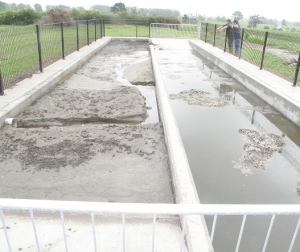Shane and wife Sarah farm at Te Poi, 10km south of Matamata. He is the third generation on a flat-to-rolling farm now covering 70ha. They milk 235 Friesian-cross cows with production exceeding 105000kgMS.
“We have set up the new shed to be run by one person with Waikato swing arm automatic cup removers.”
The former shed had 12 rows and the new 30-a-side dairy has only eight rows to complete the milking. Goldsmith milks in the morning before starting an AB run which he has been doing for 26 years. His one worker arrives at the end of milking to wash the machines and hose the dairy and yards and then he does the afternoon milking.
“The new shed with all of its features makes it easy for one person to milk in good time which also allows more paddock time for the herd.”
When designing the effluent disposal system Goldsmith wanted to process the effluent but also conserve water.
He was helped in the layout by the rolling contour with each stage gravitating to the next and allowance was made for the addition of a feed pad or a bigger herd if more adjacent land becomes available.
The stone trap has two channels 20m long x 2m wide, falling from the entrance to 1.4m deep at the end, emptying into the second channel returning another 20m to the exit where most of the solids will have been stripped from the waste. “I got the idea from my neighbour Richard Grayling, who had designed a similar trap which works well. Dave Taylor bricklaying and I made some changes and adjustments to our design once it was in use and it is now working to suit our farm practices.”
Eventually the first section will be hard enough to walk on with the material travelling underneath and the solids being stripped into the surface crust. After wash down the first section rises about 450mm and then slowly settles; The process then repeats onto the second section it takes approximately 90 minutes for the material to travel the 35m.
“This is the intention of the design, to be emptied out once a year with the front end loader. Of course this may vary depending on the amount of solid matter.”
The green water will flow into an in-ground holding tank of 25000L and the overflow to a 700,000L holding pond. This pond is made of concrete blocks waterproofed with two-pot epoxy paint. It measures 32 x 8 x 2m deep, flowing to the end where a graduated bath bottom ensures total emptying. If in future more capacity is needed the walls can be raised and beams laid to allow the entire area to be covered.
Pond agitation is by a Reid and Harrison 15hp right-angle stirrer. “With a right-angle stirrer you get better action over a greater distance and you get a better stirring action in square or rectangular ponds,” says Reid & Harrison general manager Seton Dalley. The whole pond can be fully agitated in five minutes. These stirrers are considered better for lined ponds because their action, reducing the chances of damaging the liner.
Effluent is pumped from the pond using a 15hp horizontal end pump and 90mm delivery lines feeding 63mm drag lines supplying a travelling irrigator. A flow meter will be fitted to this variable speed pump so that any sudden changes will shut the pump off. This will also ensure a consistent product applied to the paddock.
Goldsmith believes the pond gives the farm 40 -50 days of storage.
Tel. 07 888 8224. www.yardmaster-pumps.com
















